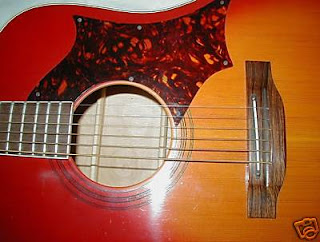A while back, I got an old Hoyer 12 String guitar to be restored or more like resurrected. I had never heard of them so research had to be done to get this job done with any integrity. The guitar's bridge and pickguard was missing and what they may have looked like was a mystery for a while! There were three holes in the top in the bridge area, but not the 12 string block holes that would be there if the bridge had the typical bridge pin set up. My next guess was the guitar may have had a separate tailpiece to anchor the strings but after careful examination, I could not find the tell tale marks of a tailpiece ever existing either. I found Hoyer guitars on the Internet but no images that looked like our Hoyer. The guitar was made in Germany and still made today, however the new ones did not resemble our old one! After much consideration, I felt the bridge must have been screwed down to the top, the saddle being adjusted for height by machine screws which would have gone through the holes in the top.. But if there were no bridge pins, how did the strings attach to the bridge? The only other possibility was a back load bridge, such as used my Ovation or Takamine guitars. I did not want to jump to that conclusion for I had never seen that type of bridge on older guitars before and this Hoyer had to come out of the late 50's or 60's. Still, there was no other explanation for the lack of bridge pin set up and no tailpiece. It must have had a back load bridge, which is a bridge with small holes on the back edge for each string to be held in before it passed over the saddle. The customer was getting impatient with my slow investigation and I was forced to make a judgement call and procure a 12 string bridge from an Ovation for this project.While I waited for the bridge to come in, I moved my investigation over the the missing pickguard. I did see evidence of a vague shape for it with 7 small screw holes in the pickguard area. By connecting the dots from the scerew holes, I could come up with a general size, though not really a specific shape for the original pickguard. Again, press for time, I decided to use a modified Martin style design from my own imagination. I drew up something that would cover the general area and cut it from tortoise shell blank from Stew-Mac Parts.It looked pretty good! I had no sooner made the pickguard and fastened it in place, when I found a photo of our Hoyer for sale on E Bay. The original pickguard was almost that of a pickguard for a Gibson Dove or Hummingbird with scallops and points. Back to Stew-Mac for another pickguard blank. I took a photo of the area of the sound hole, had it blown up to proper size and started on it. I lost track of how many hours I cut, filed and sanded. I had no sooner finished it, when the customer abruptly took the guitar from me never allowing me to install the proper guard! Any one interested in a custom Hoyer pickguard?
Subscribe to:
Post Comments (Atom)



No comments:
Post a Comment